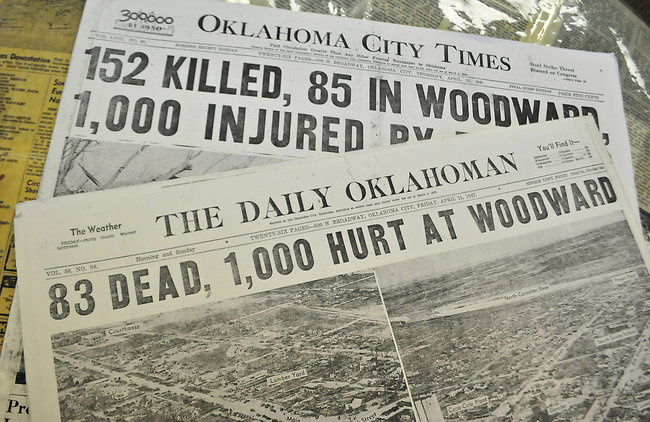My earliest memory is from six days after my third birthday.
I am with other people in a dark cellar, lit only by a small window high on one wall. Someone is holding me up to the window, where I see nothing but dim grey light outside with shadowy objects blowing by.
It is just a brief image. For years I didn’t know if it was a real memory, or a dream.
I know now it is a real memory.
It was April 9, 1947, in Woodward, Oklahoma. I was with my mother, father, and older sister in the cellar of our house, and we were in the middle of an F5 tornado. My sister has told me it happened like this:
If you have lived in Oklahoma, you know that the wind blows all the time there. All the time. It’s a plains state. On this April evening my father noticed the wind had suddenly stopped. He went outside, assessed the still air, and looked up at a strange, greenish sky. Oklahoma is located in the middle of what is known as Tornado Alley. If you grow up in Oklahoma, as my father did, you come to know what that sudden lack of wind and greenish-colored sky means. He came in the house saying we should go down to the cellar.
So down into the cellar we went. Shortly after, at 8:42 pm, the F5 tornado struck Woodward without warning.
Back then there were no tornado warning systems as there are today. So we did not know that this tornado was part of a series of five or six tornadoes spawned by a super cell in the Texas Panhandle. They made a track up through the Texas Panhandle, into northwest Oklahoma, and ended in southeast Kansas, leaving a deadly path of destruction. The strongest and deadliest of these tornadoes was the F5 that struck Woodward, population 5,500.
To this day the 1947 Woodward tornado is still the deadliest in Oklahoma history, and the sixth deadliest in U.S. history. It was reportedly two miles wide when it hit Woodward. It reduced much of the town to rubble, killed over 80 people, and injured 1,000 more. All in a town of 5,500.
Our family survived uninjured and our house undamaged. We were just outside the tornado’s path.
That night, after the tornado passed, and for the next several days afterward my father went out with other uninjured survivors to look for the dead and help the injured. As he worked he took black and white photos of the devastated town.
The map and photos at the bottom of this post are from the 1947 Woodward tornado, but they are not my father’s pictures. His photos were a treasured part of our family history, but after our mother’s death my sister and I could not find them in the family albums at the house. We don’t know what happened to them. Our mother was also a native Oklahoman with a strong sense of state history, and we think she may have donated them to the Oklahoma Historical Society. A generous gift from her to the society’s museum, but a disappointment for her daughters.
Since then I’ve found photos of the 1947 Woodward tornado online, and the pictures here are a sample of them. They are mementos of my first memory and a major event in my life’s history, but it is not the same as having the ones from our father’s camera.
Peace and Joy,
Marjorie Beck
Thank you for reading this post. If you like it, follow the blog and you will get notices of new posts.






